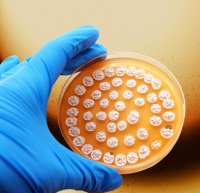Chemical & Materials Sciences Division
Research Highlights
July 2012
Listening to Life
New chemical imaging method probes the communications of live microbial colonies
Results: Once impossible, scientists can now eavesdrop on microbes, thanks to a new technique from scientists at Pacific Northwest National Laboratory and three universities. Microbes converse by releasing simple and complex molecules, called metabolites. The metabolites interact with and alter their environment and nearby cells. To listen in, the team combined nanospray desorption electrospray ionization mass spectrometry, or nanoDESI, and a new bioinformatics technique. This approach allows scientists to identify and quantify, in time and space, the metabolites around living bacterial colonies.
"This is a real discovery tool—showing us how microbial communities interact," said Dr. Julia Laskin, a PNNL chemist who has been successfully advancing the frontiers of nanoDESI for three years.
Why It Matters: Understanding the timing and distribution of metabolite exchanges will help interpret and potentially manipulate microbial communities. For example, by studying how Shewanella oneidensis colonies respond to their environment and other strains of bacteria, scientists can gain insights into how the microbe makes mobile uranium stationary. Another example, scientists can determine how brain cells respond to nicotine and other toxins. The new nanoDESI-based technique offers the insights scientists want.
"Microbial biology covers topics from biofuel production to bioremediation to health to defense," said Dr. Pieter Dorrestein, who led the development of the new bioinformatics technique and is an Associate Professor at the University of California, San Diego.
Methods: Previously, scientists weren't able to sample a microbial community more than once. The sampling process destroyed the colony. With the new technique, scientists can sample a community repeatedly, gaining a time-lapse view of metabolite production and use.
"Being able to sample the same colony over and over is a huge advance in the microbial community," said Brandi Heath, a postgraduate student who has been working on nanoDESI since coming to PNNL as an undergraduate intern in 2010.
Developed in 2009, nanoDESI is based on a gentle liquid extraction of molecules from a sample. The process relies on two thin glass tubes or capillaries. The input capillary produces a small drop of liquid that contacts the microbial colony. The output capillary draws off the liquid, which now contains the metabolites produced by the colony. The analyte is transferred into the mass spectrometer.
The data from the mass spectrometer is analyzed, organized, and visualized using molecular networking. During high-resolution mass spectrometry analysis, thousands of molecules are detected, and structural information is gathered about these molecules by breaking them into fragments. Molecular networking assigns each molecule to a family with shared structural characteristics based on the observed fragmentation patterns. In this case, the molecular networking revealed insights about how microbial communities communicate.
"Great discoveries often require great tools," said Dr. Louis Terminello, who leads the Chemical Imaging Initiative at PNNL. "The discoveries needed to solve today's problems aren't something that you're going to get by eyeballing a sample and analyzing a spreadsheet."
What's Next? "There is a lot of ‘next,'" said Laskin. The team is using nanoDESI to analyze different microbial communities of interest to the Department of Energy. Their studies include metabolites produced by certain bacteria of interest in bioremediation. They are also looking at metabolic exchanges between different photosynthesizing bacteria for biofuels production.
Acknowledgments:
Sponsors: This work was supported by PNNL's Chemical Imaging Initiative and the National Institutes of Health, Johnson & Johnson, the German Research Foundation, Dutch Science Organization Ecology Regarding Gene-Modified Organisms, Netherlands Genomics Initiative ECOLINC and PreSeed, and PNNL's Science Undergraduate Laboratory Internship program.
User Facility: EMSL
Research Team: Jeramie Watrous, Jane Yang, Roland Kersten, Kit Pogliano, Bradley S. Moore, Nuno Bandeira, and Pieter C. Dorrestein, University of California at San Diego; Patrick Roach, Brandi Heath, and Julia Laskin, PNNL; Theodore Alexandrov, UCSD and University of Bremen; Menno van der Voort and Jos Raaijmaker, Wageningen University; Harald Gross, University of Bonn.
Reference: J Watrous, P Roach, T Alexandrov, BS Heath, JY Yang, RD Kersten, M van der Voort, K Pogliano, H Gross, JM Raaijmaker, BS Moore, J Laskin, N Bandeira, and PC Dorrestein. 2012. "Mass Spectral Molecular Networking of Living Microbial Colonies." Proceedings of the National Academy of Sciences of the United States of America 109(26):E1743-E1752. DOI:10.1073/pnas.1203689109.

